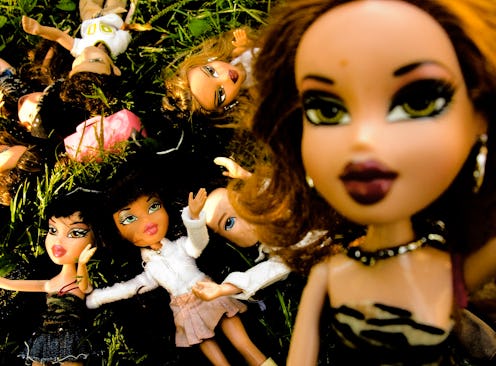
I was already 16 by the time Bratz dolls hit shelves in 2001, so by the time I got wind of them, it was more because of the controversy they were stirring up than because I was interested in playing with them myself. But now a Tumblr project called Tree Change Dolls is attempting to take old Bratz dolls and turn them into something new by giving them little dolly "makeunders." The Tumblr features Bratz dolls acquired at second-hand shops and dramatically redesigned, with "high maintenance glitz 'n' glamour [swapped] for down-to-earth style." But although my initial reaction was "Neat-o!", the more I looked at them, the more I began to wonder if maybe they weren't quite as awesome as they at first seemed. The issue is a complicated one, and I think, ultimately, that replacing a doll represents one specific definition of what it means to be a girl with another that has a different but equally specific definition of what it means to be a girl might be too simplistic a solution to really tackle the problem.
There's no getting around it: Bratz do present something of a problem. They trot out a sexualized image of hyperfeminity both to kids in general and to the girls at whom they're specifically targeted; it's likely that most kids would be better off not getting those messages at such an early age. For that reason,Tree Change Dolls appeal to me for the same reason that, say, Lammily does: I dig the fact that the dolls look more like the kids who would presumably be playing with them — both stylistically and age-wise — than Bratz in their original form do. It's an attempt to reverse the "Kids Getting Older Younger" phenomenon Peggy Orenstein wrote about in Cinderella Ate My Daughter; the "high maintenance glitz 'n' glamour for down-to-earth style" swap made by transforming Bratz into Tree House Dolls encourages kids to enjoy being the age they are, rather than hurrying so much to "grow up."
At the same time, though, I'm not sure "making them under" like this is really the answer, either. Looking at the Tree Change Dolls' "before" and "after" photos, I can't help but think that once their makeup has been stripped away, their facial features reformed, and their clothing replaced, they all look... well, kind of similar. They're so homogenous, in fact, that they all may as well be the same doll. Part of that eerie similarity is just the nature of mass-produced toys; the dolls were probably all originally cast from the same mold, with the "set dressing" — the makeup and the clothes — being what sets them apart from each other. But at the same time, the "madeunder" dolls send an equally problematic message as the "overly made-up" ones: In one case, it's "Dress sexy, even if you don't know what 'sexy' means!"; in the other, it's "Dress exactly the same as everyone else!"
But it even goes beyond that: Both the original Bratz and the Tree Change Dolls present one definition of what it means to be a girl, and one definition only, and that, I think, is the real problem. The gender and sexuality blog Binary This, which holds the tagline, "Everything you always wanted to know about gender but were too afraid to ask," also acknowledges that while Bratz are troubling, the solution may not be to totally change their appearances: "The reason to be deeply concerned about these Tree Change Dolls is that they represent a broader trend toward securing a fixed sense of what a real girl looks like — rather than disrupting the normal when it comes to gender." Talk about hitting the nail on the head.
I think the bigger picture of the whole Bratz vs. Tree Change Dolls debate is about this: Our definition of "femininity" — and thus the one we pass on to our kids — can't just boil the word down to one thing or another. If we're going to try to define what it means to be a girl, we need a definition that has room for all possibilities — something that's open and expansive, rather than narrow and limited. Playing dress-up when you're a kid or wearing makeup when you get older aren't inherently bad; neither are not playing dress-up or not wearing makeup. They're both perfectly valid choices — and there are plenty of other valid choices out there besides those ones, too. Why should anyone, child or adult, have to pick just one?
Images: Nina H, callme_crochet, Softness/Flickr